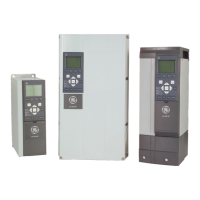9.2.3 Modbus RTU Message Structure
The transmitting device places a Modbus RTU message
into a frame with a known beginning and ending point.
This allows receiving devices to begin at the start of the
message, read the address portion, determine which
device is addressed (or all devices, if the message is
broadcast), and to recognize when the message is
completed. Partial messages are detected, and errors are
set as a result. Characters for transmission must be in
hexadecimal 00 to FF format in each field. The adjustable
frequency drive continuously monitors the network bus,
also during ‘silent’ intervals. When the first field (the
address field) is received, each adjustable frequency drive
or device decodes it to determine which device is being
addressed. Modbus RTU messages addressed to zero are
broadcast messages. No response is permitted for
broadcast messages. A typical message frame is shown in
Table 9.4.
Start Address Function Data CRC
check
End
T1-T2-T3-
T4
8 bits 8 bits N x 8
bits
16 bits T1-T2-T3-
T4
Table 9.4 Typical Modbus RTU Message Structure
9.2.3.1 Start/Stop Field
Messages start with a silent period of at least 3.5 character
intervals. This is implemented as a multiple of character
intervals at the selected network baud rate (shown as Start
T1-T2-T3-T4). The first field to be transmitted is the device
address. Following the last transmitted character, a similar
period of at least 3.5 character intervals marks the end of
the message. A new message can begin after this period.
The entire message frame must be transmitted as a
continuous stream. If a silent period of more than 1.5
character intervals occurs before completion of the frame,
the receiving device flushes the incomplete message and
assumes that the next byte is the address field of a new
message. Similarly, if a new message begins prior to 3.5
character intervals after a previous message, the receiving
device will consider it a continuation of the previous
message. This causes a timeout (no response from the
slave), since the value in the final CRC field is not valid for
the combined messages.
9.2.3.2 Address Field
The address field of a message frame contains 8 bits. Valid
slave device addresses are in the range of 0–247 decimal.
The individual slave devices are assigned addresses in the
range of 1–247. (0 is reserved for broadcast mode, which
all slaves recognize.) A master addresses a slave by placing
the slave address in the address field of the message.
When the slave sends its response, it places its own
address in this address field to let the master know which
slave is responding.
9.2.3.3 Function Field
The function field of a message frame contains 8 bits. Valid
codes are in the range of 1-FF. Function fields are used to
send messages between master and slave. When a
message is sent from a master to a slave device, the
function code field tells the slave what kind of action to
perform. When the slave responds to the master, it uses
the function code field to indicate either a normal (error-
free) response, or that some kind of error occurred (called
an exception response). For a normal response, the slave
simply echoes the original function code. For an exception
response, the slave returns a code that is equivalent to the
original function code with its most significant bit set to
logic 1. In addition, the slave places a unique code into the
data field of the response message. This tells the master
what kind of error occurred, or the reason for the
exception.
Function Function Code
Read coils 1 hex
Read holding registers 3 hex
Write single coil 5 hex
Write single register 6 hex
Write multiple coils F hex
Write multiple registers 10 hex
Get comm. event counter B hex
Report slave ID 11 hex
Table 9.5
Function Function
Code
Sub-
function
code
Sub-function
Diagnostics 8 1 Restart communication
2 Return diagnostic register
10 Clear counters and
diagnostic register
11 Return bus message count
12 Return bus communi-
cation error count
13 Return bus exception error
count
14 Return slave message
count
Table 9.6
RS-485 Installation and Set...
AF-650 GP
TM
Design and Installation Guide
9-2 DET-767A
9

